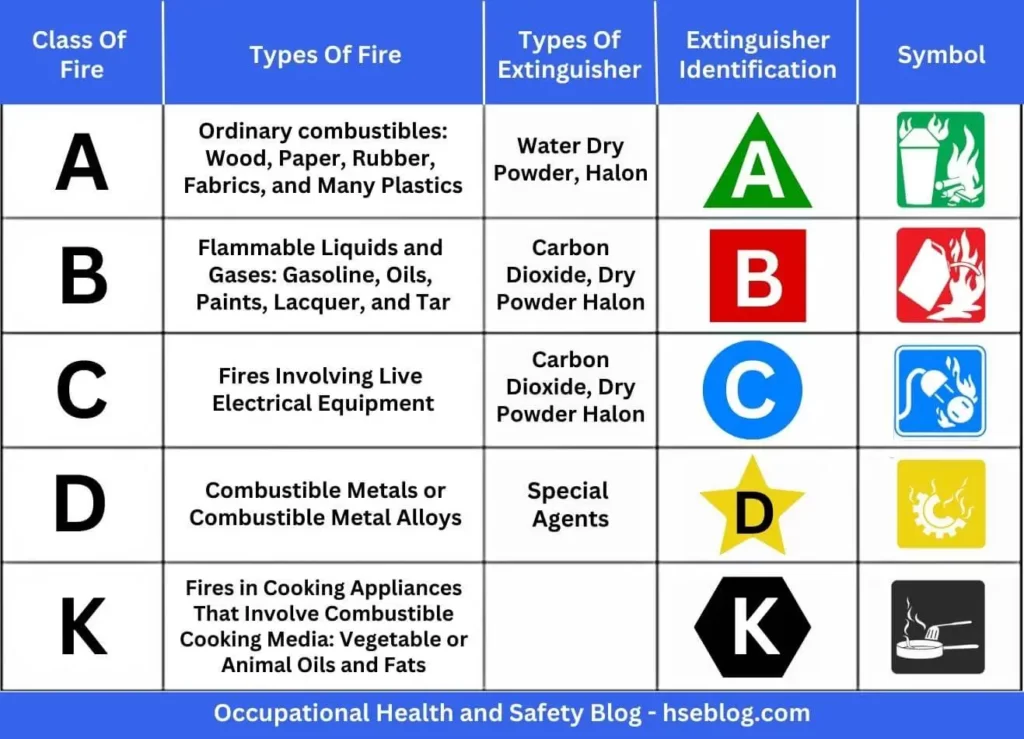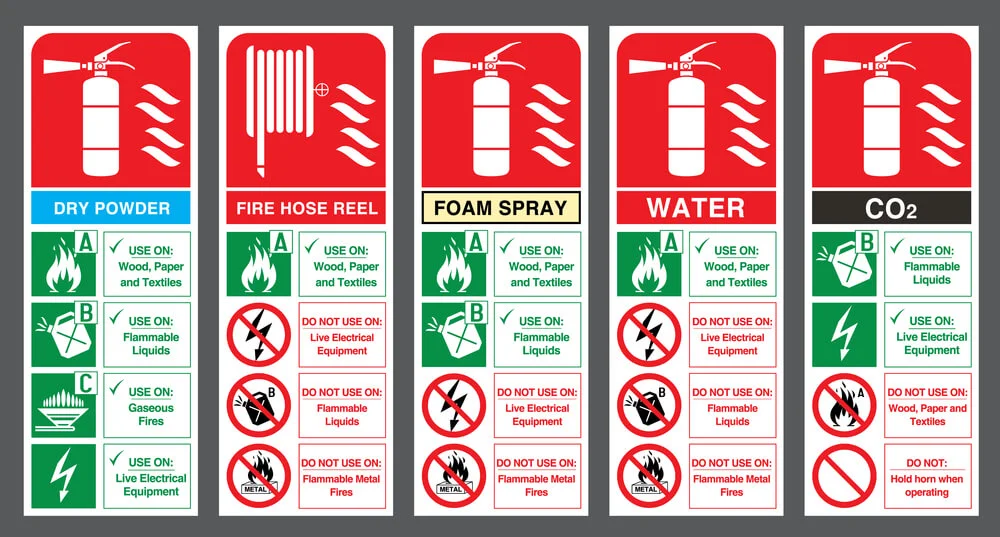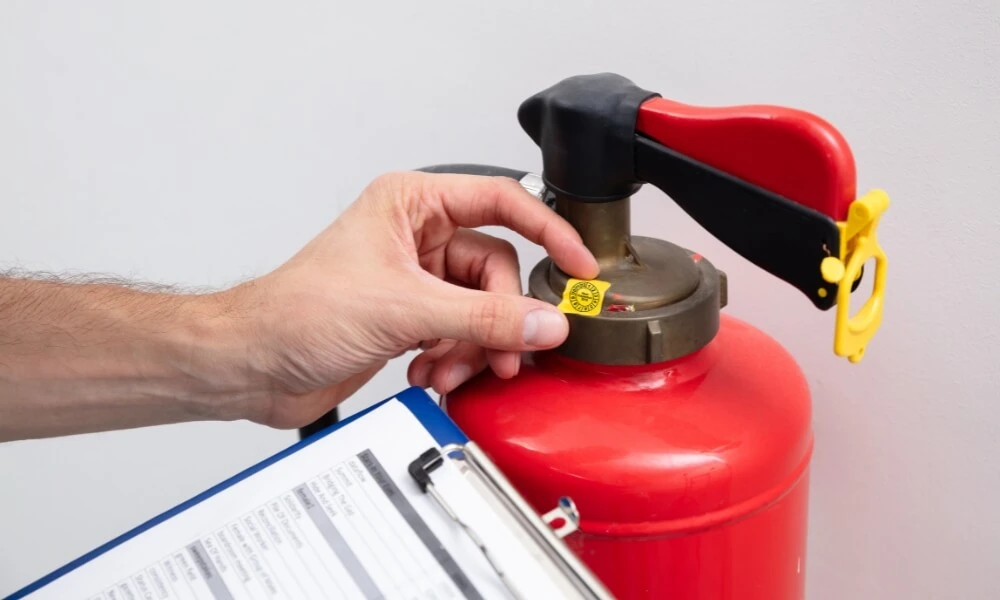In the heat of an emergency, every second counts. That’s particularly true when the emergency involves fire. That’s why we have fire extinguishers – powerful tools that can control and even extinguish fires before they become full-blown disasters. But these life-saving devices are only as useful as our knowledge of how to operate them. One of the key elements to using a fire extinguisher effectively is understanding the symbols on its body.
“What Do The Symbols On A Fire Extinguisher Indicate?” – this question we often overlook until we are faced with an actual fire emergency. However, this knowledge is vital for everyone, as different symbols indicate different applications, and using the wrong extinguisher can, at best, be ineffective and, at worst, exacerbate the situation.
In this blog, we’ll break down these symbols, color codes, and pictograms, providing you with the knowledge to tackle fires safely and effectively. After all, when it comes to fire safety, knowledge truly is power!

What Do The Symbols On A Fire Extinguisher Indicate?
Fire extinguishers typically have labels or symbols that provide important information about their use and capabilities. These symbols are essential for users to understand how to operate the extinguisher safely and effectively. Here are the common symbols found on a fire extinguisher:
Understanding Fire Classifications
Fires are classified based on the type of fuel involved. There are five classes:
- Class A: Involve ordinary combustibles like wood, paper, and cloth.
- Class B: Involve flammable liquids such as gasoline, oil, and grease.
- Class C: Involve electrical equipment and wiring.
- Class D: Involve combustible metals like magnesium, potassium, and sodium.
- Class K: Involve cooking oils and fats, typically found in kitchen fires.
The type of fire determines the appropriate extinguisher to use, and using the wrong one can worsen the situation.
Pictograms
Pictograms are graphical representations that help users quickly understand the kind of fires a particular fire extinguisher is designed to combat. These symbols are meant to be self-explanatory, thus overcoming any language barriers. Here are more details on the pictograms:
- Class A Fires: The pictogram for this class usually shows a picture of a trash can and a wood log. The trash can and wood log symbolize ordinary combustibles such as paper, wood, textiles, and certain plastics.
- Class B Fires: For this class, the pictogram often displays an image of a gas can. This symbol represents flammable and combustible liquids like petrol, kerosene, oil, and grease.
- Class C Fires: This class’s pictogram generally features an electrical plug and outlet. The plug and outlet indicate electrical fires originating from overloaded electrical outlets or short-circuited equipment.
Each pictogram is usually contained within a shape—circle, square, or triangle—to further distinguish the classes.
Numerical Ratings
Numerical ratings on fire extinguishers denote their capacity to extinguish certain types of fires. For instance, a 2A rating indicates that the extinguisher is as effective as 2.5 gallons of water on a Class A fire. Similarly, a 10B rating denotes that the extinguisher can cover roughly 10 square feet of a Class B fire.
The extinguisher’s numerical rating helps the user gauge its efficacy against a particular type of fire. Note that there is no numerical rating for Class C fires as the efficacy here is determined by the ability to de-energize the source of electricity.
Extinguishing Agent Symbols
Extinguishing agent symbols indicate the material used within the extinguisher to put out fires. Different agents are used for different classes of fires:
- Water: Typically found in a red-colored extinguisher, water is used for Class A fires.
- Foam: Foam can be used for Class A and B fires found in cream-colored extinguishers.
- Dry Powder: Indicated by a blue label, dry powder is used for Class A, B, and C fires and, in some cases, Class D fires.
- CO2: Housed in black-colored extinguishers, Carbon Dioxide is typically used for Class B and C fires and is safe for electrical fires.
Maintenance and Inspection Tags
Maintenance and inspection tags are indicators of an extinguisher’s condition and readiness for use. These tags often record:
- The date of the last inspection: Regular inspections are essential to ensure the extinguisher is still in working order.
- Maintenance activities performed: This could include refilling the extinguisher, replacing parts, or other necessary updates.
- The name and signature of the person who performed the inspection: This is important for accountability.
Keeping track of these tags is crucial as an extinguisher’s efficacy depends on its good working condition. Fire extinguishers should be professionally inspected at least once a year and serviced as required.
By understanding these symbols, one can effectively select and use a fire extinguisher in the event of a fire, potentially saving lives and property.

Color Coding of Fire Extinguishers
The color coding of fire extinguishers is an easy visual guide to identify the extinguishing agent used within the extinguisher. Each color corresponds to a specific type of fire extinguishing agent and, consequently, the types of fires each extinguisher is equipped to handle. Let’s dive into more detail:
- Red: Water (Class A): Extinguishers with a red label or body are water-based. Water extinguishers are primarily used for Class A fires involving ordinary combustibles like wood, paper, and cloth. Water extinguishes this type of fire by cooling the burning material, eliminating the heating element of the fire triangle (fuel, heat, oxygen).
- Cream: Foam (Class A & B): Cream-labeled extinguishers contain foam as an extinguishing agent. Foam extinguishers are effective against both Class A and Class B fires. They extinguish Class A fires by cooling the fire and coating the fuel, while for Class B fires, the foam forms a seal on the surface of the liquid, preventing flammable vapors from being released.
- Blue: Dry Powder (Class A, B, C, and some D): Blue-labeled extinguishers are dry powder extinguishers. They are versatile, combat Class A, B, and C fires and sometimes Class D fires (depending on the type of powder used). Dry powder extinguishes fires by interrupting the chemical reaction within a fire.
- Black: Carbon Dioxide (CO2) (Class B & C): Black-labelled extinguishers contain CO2. They are primarily used for Class B and C fires. CO2 extinguishes fires by displacing the oxygen around the fire and cooling the fuels due to the cold discharge.
- Yellow: Wet Chemical (Class A & K): Fire extinguishers labeled with yellow contain a wet chemical. They are designed to combat Class A fires and, more importantly, Class K fires, which are fires caused by cooking oils and fats. The wet chemical extinguishes such fires by reacting with the oil or fat to create a cooling, soapy layer on the surface, thus starving the fire of fuel.
It is important to note that these colors may cover a significant portion of the extinguisher or be a band, depending on the country’s regulations. For instance, in the UK, the entire body of the fire extinguisher used to be color-coded, but modern UK extinguishers showcase a red body (indicating fire-fighting usage) with a specific color band to indicate the extinguishing agent.
Remember, quickly identifying the right fire extinguisher in a fire emergency can be crucial, and the color coding system assists in achieving this. It is always a good idea to familiarize oneself with the fire extinguishers in your environment.
How to Use a Fire Extinguisher
Proper use of a fire extinguisher can be remembered through the acronym PASS:
- Pull the pin.
- Aim low at the base of the fire.
- Squeeze the handle to release the extinguishing agent.
- Sweep the nozzle from side to side.
Remember, safety is paramount, and you should always use the correct type of extinguisher for the fire at hand.
Conclusion
In conclusion, understanding the symbols on a fire extinguisher isn’t just a matter of intellectual curiosity; it’s a practical safety measure that can make a significant difference in an emergency. These symbols, representing fire classes, numerical ratings, extinguishing agents, and maintenance information, are integral guides that ensure extinguishers’ proper and efficient use. Color coding further simplifies the identification process, giving us vital clues.
Being familiar with these symbols empowers us to act swiftly and appropriately, potentially saving lives and property from the devastating impact of uncontrolled fires. As with many safety aspects, awareness and preparation are our best allies, and a moment spent learning today could be a lifesaver tomorrow.

